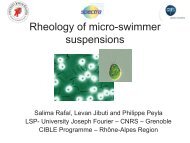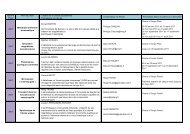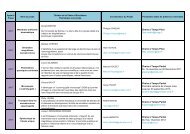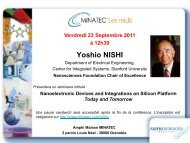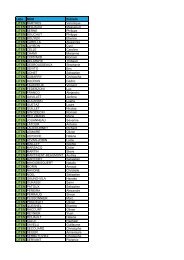Partie I : Un robot suiveur de Ligne - Fondation Nanosciences
Partie I : Un robot suiveur de Ligne - Fondation Nanosciences
Partie I : Un robot suiveur de Ligne - Fondation Nanosciences
Create successful ePaper yourself
Turn your PDF publications into a flip-book with our unique Google optimized e-Paper software.
Dans la figure D7, la sortie "RA0" correspond à la donnée qui <strong>de</strong>vra être traitée par le PIC, "GND"à la masse, et "5V" à l'entrée <strong>de</strong> 5V permettant d'alimenter en dérivation la DEL IR et le phototransistorau niveau du collecteur.B - Le contrôleur programmable intelligent 16F84 :Comme nous l'avons précisé dans le paragraphe II-A, nous avons besoin d'un processeur afin qu'ilpuisse exécuter les algorithmes que nous avons conçus. Comme nous n'avons pas un programmetrop complexe, nous avons choisi le PIC 16F84, ou en anglais 'Programmable intelligent controller14-bit flash-program-memory (84:ref)'. On trouve d'autre part <strong>de</strong> nombreux tutoriaux sur Internetexpliquant simplement et <strong>de</strong> manière détaillée son fonctionnement (cours <strong>de</strong> Bigonoff) ou ladatasheet du composant <strong>de</strong> Microchip (R) pourrait suffire.Figure représentant la disposition <strong>de</strong>s pattes sur le CI



